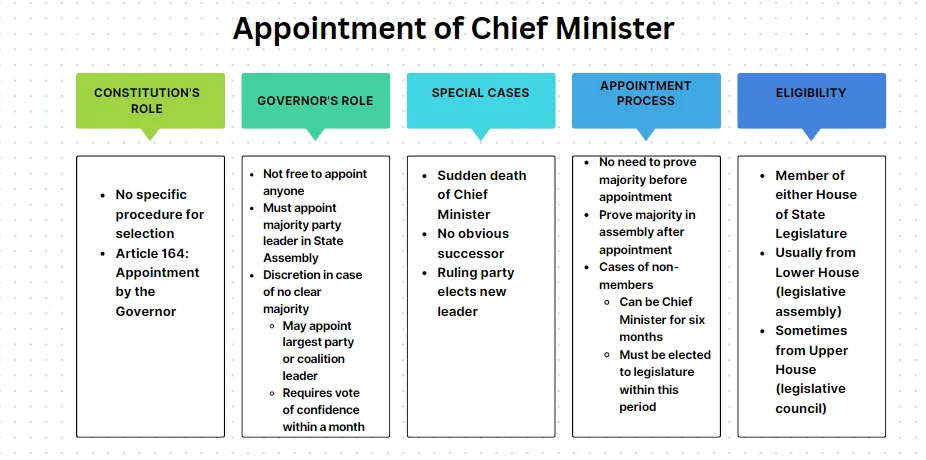The Chief Minister, the de facto executive authority in a state, plays a crucial role in India’s parliamentary system, mirroring the role of the Prime Minister at the national level. Appointed by the Governor, the Chief Minister leads the Council of Ministers, guiding state governance and administration. This position entails significant responsibilities and powers, influencing state policy and maintaining communication between the state and central government.
The Role of Chief Minister in India’s Federal System
De Facto Executive Authority in India’s States
- De Jure Head of the State: Under the Parliamentary system established by the Constitution, the Governor is a state’s de jure head, but de facto executive authority rests with the Chief Minister.
- Executive Authority: Title vs. Power: This means the Governor holds the title of executive authority, while the Chief Minister exercises actual executive power.
- Therefore the Governor is the state’s ceremonial leader, and the Chief Minister as the leader of the state government.
- Chief Minister vs. Prime Minister: Consequently, the role of the Chief Minister in a state is comparable to that of the Prime Minister at the national level.
Enroll now for UPSC Online Course

Appointment of Chief Minister and other members |
|
| Article 164 |
|
|
|
|
|
|
|
|
|
Oath, Salaries and the term of the Chief Minister
| Category | Related Details |
| Oath Administered |
|
| Oath of Office |
|
|
|
|
|
|
|
| Oath of Secrecy |
|
| Term of Office |
|
|
|
|
|
|
|
| Salary and Allowances |
|
|
|
|
Multiple Powers and Functions of the Chief Minister
- In Relation to Council of Ministers
-
-
- Recommends person to be appointed as minister to the Governor
- Allocates and reshuffles portfolios among ministers
- Can ask a minister to resign or advise the Governor to dismiss
- Presides over council meetings and influences decisions
- Guides, directs, controls, and coordinates ministerial activities
- Can dissolve the council by resigning
-
- In Relation to the Governor
-
-
- Principal channel of communication between Governor and council
- Communicates state administration decisions and legislative proposals
- Furnishes information and submits matters for council consideration
- Advises on appointments of key officials
-
- In Relation to State Legislature
-
-
- Advises on summoning and proroguing legislative sessions
- Can recommend dissolution of the legislative assembly
- Announces government policies in the house
-
- Other Powers and Functions
-
-
- Chairman of the State Planning Board
- Vice-chairman of the zonal council by rotation
- Member of the Inter-State Council and NITI Aayog Chief spokesman of the state government
- Crisis manager-in-chief during emergencies
- Engages with public and addresses their problems
-
- Political head of the services
- Overall Role
-
- Significant role in state administration
- Influence moderated by the Governor’s discretionary powers
Relationship of the Chief Minister with the Governor
| Constitutional Article | Provision | Details |
| Article 163 | Council of Ministers |
|
| Article 164 | Appointment and Tenure of Ministers |
|
| Article 167 | Duties of the Chief Minister |
|
Similarities in Chief Minister and Prime Minister at the Union and the State level
| Particulars | Union | State |
| Appointment | Prime Minister | Chief Minister |
| Appointing Authority | President | Governor |
| Advice for Appointments of Council of Minister | Prime Minister | Chief Minister |
| Membership | Lok Sabha or Rajya Sabha | Legislative Assembly or Legislative Council |
| Oath of Office and Secrecy | Administered by President | Administered by Governor |
| Chief Executive | Prime Minister (real), President (nominal) | Chief Minister (real), Governor (nominal) |
| Policy Coordination and Department Supervision | Prime Minister | Chief Minister |
| Communication with Head of State | Prime Minister to President | Chief Minister to Governor |
| Ministerial Appointments and Portfolio Allocation | Prime Minister decides, advises President | Chief Minister decides, advises Governor |
| Dissolution of Council of Ministers | Prime Minister’s death/resignation | Chief Minister’s death/resignation |
| Filling Vacancies | New Prime Minister and Council sworn-in | New Chief Minister and Council sworn-in |
| Individual Minister’s Death/Resignation | Creates vacancy only, filled by new appointment | Creates vacancy only, filled by new appointment |
- Shared Responsibilities: The Prime Minister and Chief Minister share similar responsibilities within their respective jurisdictions.
- Both roles involve communicating decisions and information to the President and Governor, respectively, regarding government administration and proposed legislation.
- Additionally, they are tasked with furnishing information as requested and submitting matters for consideration by their respective councils, if required.
- Legislative Proposals: In terms of legislation, both the Prime Minister and Chief Minister play a crucial role in proposing laws for their respective levels of government.
- Leadership Role: They are also responsible for leading the Council of Ministers and overseeing the overall administration of their respective areas.
- Representation: Furthermore, both roles involve representing the government at the national and international levels, as well as serving as the leader of the majority party in the national or state legislature.
- Additionally, both the Prime Minister and Chief Minister may hold additional ministerial portfolios beyond their leadership roles.
Enroll now for UPSC Online Course
| Must Read | |
| Current Affairs | Editorial Analysis |
| Upsc Notes | Upsc Blogs |
| NCERT Notes | Free Main Answer Writing |
Conclusion
The role of the Chief Minister is pivotal in the effective governance of a state, balancing ceremonial duties with substantial executive powers.
- By working closely with the Governor, the Chief Minister ensures smooth administration and legislative progress. Both the Chief Minister and Prime Minister share similar functions, emphasizing the importance of their roles in India’s federal structure.
- Strengthening this office through reforms can enhance governance and uphold democratic principles.
Sign up for the PWOnlyIAS Online Course by Physics Wallah and start your journey to IAS success today!
| Related Articles | |
| State Legislature in India | Chief Minister |
| Parliamentary System | The Council of Ministers: Union and State in India |

 GS Foundation
GS Foundation Optional Course
Optional Course Combo Courses
Combo Courses Degree Program
Degree Program











